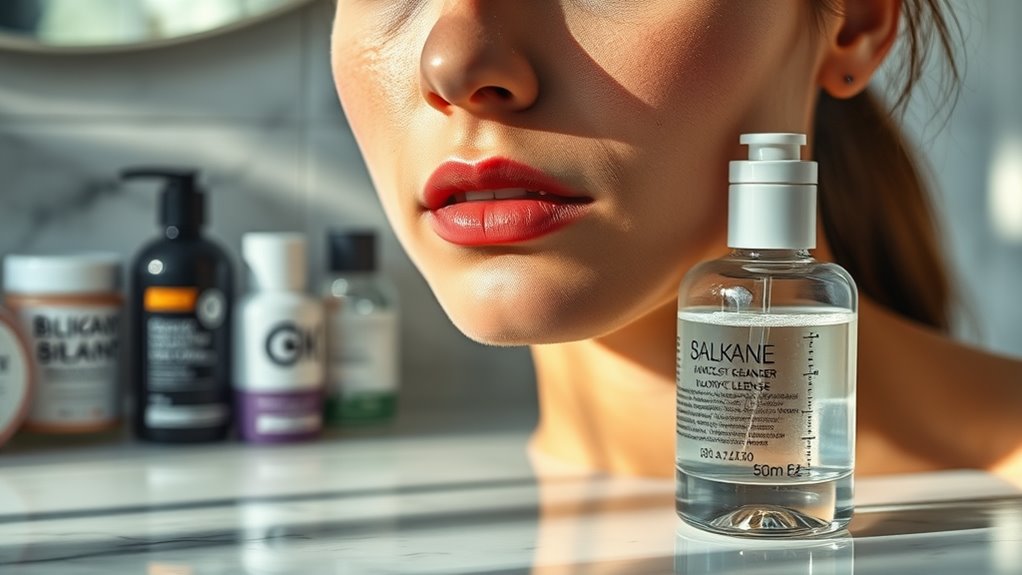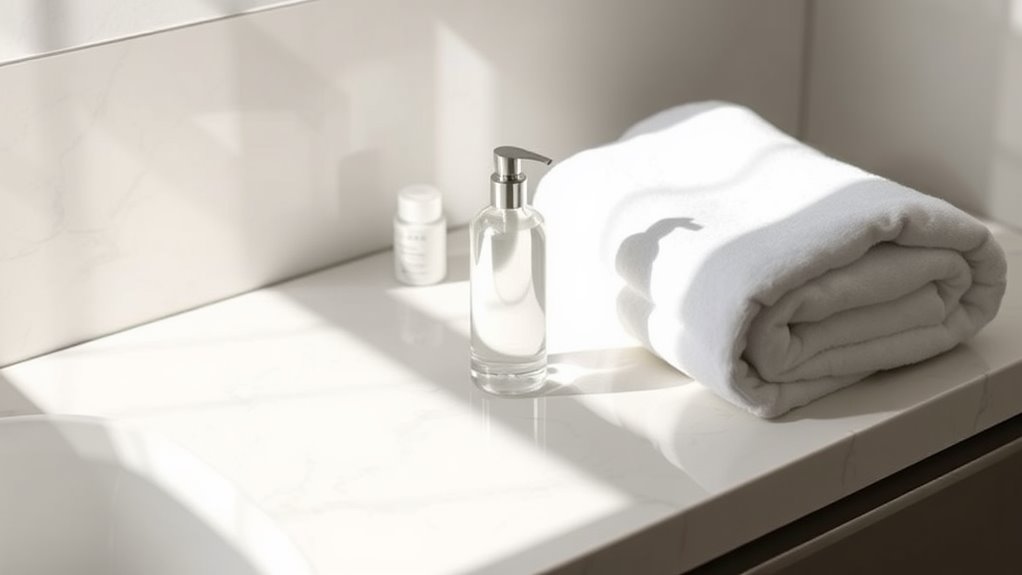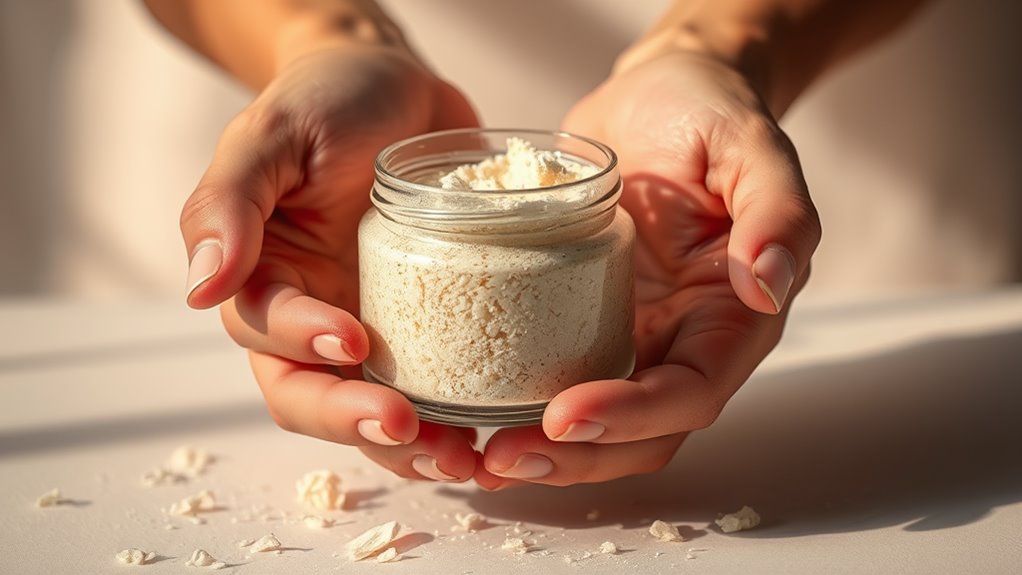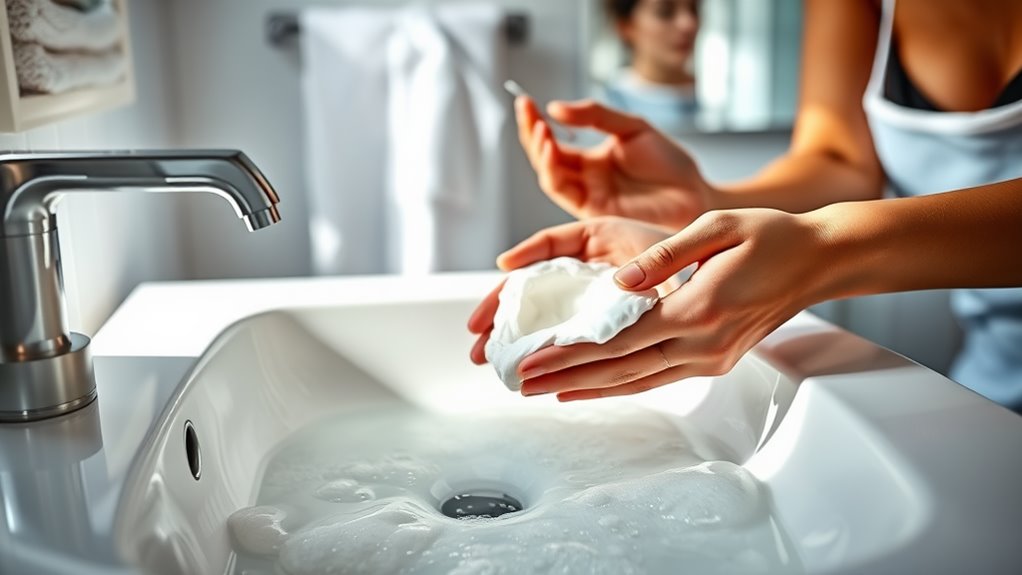How to Tell If You’re Over-Cleansing Your Skin
If you’re over-cleansing your skin, you might notice increased dryness, tightness, or redness. Irritation and sensitivity to products can occur, as well as breakouts from disrupted oil production. Your complexion may appear dull and lackluster, indicating an imbalance in hydration. Frequent skin rashes or changes in texture may also arise, signaling a compromised skin barrier. Recognizing these signs can help you adjust your routine effectively. Discover more strategies to restore your skin’s health and vitality.
Key Takeaways
- Increased dryness and tightness after cleansing may indicate that you are over-cleansing your skin.
- Redness and irritation, such as burning sensations, suggest distress from harsh cleansing products.
- Sensitivity to familiar products, leading to unexpected reactions, can signal a compromised skin barrier.
- Frequent breakouts and acne flare-ups can result from excessive cleansing disrupting natural oil production.
- A dull and lackluster complexion often indicates that your skin is stripped of essential oils.
Increased Dryness and Tightness
Increased Dryness and Tightness
If you’ve noticed increased dryness and tightness in your skin, it could be a sign that you’re over-cleansing.
Over-cleansing signs manifest as a compromised skin barrier, leading to moisture loss and heightened sensitivity. When you cleanse too frequently or use harsh products, you strip away essential oils necessary for hydration. This disruption results in a feeling of tightness, especially after washing your face. Additionally, over-cleansing your skin can trigger irritation and redness, further indicating that your routine needs adjustment.
To achieve mastery in skincare, assess your cleansing routine. Consider reducing the frequency of cleansing, opting for gentler formulations, and incorporating hydrating ingredients.
Monitor your skin’s response; if dryness persists, it’s crucial to reevaluate your cleansing practices. Understanding these over-cleansing signs is essential for maintaining optimal skin health and achieving a balanced complexion.
Redness and Irritation
If you notice redness and irritation on your skin, it may signal distress from over-cleansing. Common causes include the use of harsh cleansers or excessive scrubbing, which can compromise your skin’s barrier. Recognizing these signs early is crucial to restoring your skin’s health and comfort. Additionally, cleansing mistakes such as using overly hot water can exacerbate skin sensitivity and irritation.
Signs of Skin Distress
Redness and irritation are two primary signs that your skin may be experiencing distress from over-cleansing. When you notice areas of redness, it indicates increased blood flow to the skin, often a response to irritation. This can manifest as localized patches or a general flushing of the face.
Irritation, on the other hand, may present as dryness, flakiness, or a burning sensation, signaling that your skin barrier is compromised. These symptoms may also be accompanied by tightness or discomfort, making normal daily activities feel irritating.
If you observe these signs consistently, it’s crucial to reassess your cleansing routine. Adjusting the frequency or type of cleanser can help restore your skin’s natural balance, promoting a healthier complexion.
Causes of Irritation
While various factors can contribute to skin irritation, over-cleansing is a primary culprit. When you cleanse excessively, you disrupt the skin’s natural barrier, leading to increased transepidermal water loss and subsequent dehydration.
This imbalance manifests as redness, flakiness, and heightened sensitivity. Harsh cleansers, particularly those with sulfates or alcohol, exacerbate this irritation by stripping essential oils.
Additionally, frequent exfoliation can further compromise the barrier, making your skin more susceptible to environmental irritants.
It’s crucial to assess your cleansing routine and recognize that less is often more. You should aim for a gentle, hydrating cleanser and limit washes to twice daily, allowing your skin to recover and maintain its protective functions.
Breakouts and Acne Flare-Ups
When you cleanse excessively, you strip your skin of essential natural oils, disrupting its lipid barrier. This disruption leads to increased oil production as your skin tries to compensate, which can clog pores and trigger acne.
Moreover, over-cleansing can provoke inflammation and irritation, further exacerbating existing breakouts. The skin may also become hypersensitive, making it more reactive to environmental aggressors and certain products.
In a compromised state, the skin’s ability to heal diminishes, allowing bacteria to thrive and increase the likelihood of flare-ups. To avoid this, remember that a common cleansing mistake can significantly impact your skin’s health.
To maintain balance, adopt a gentle cleansing routine tailored to your skin type, allowing it to function optimally without unnecessary stress.
Dull and Lackluster Complexion
Over-cleansing your skin doesn’t just lead to breakouts; it can also result in a dull and lackluster complexion.
When you strip your skin of its natural oils through excessive cleansing, you disrupt the skin barrier, which plays a crucial role in maintaining hydration and radiance. This disruption often manifests as a lack of luminosity, making your skin appear tired and lifeless.
You may notice an increase in dryness and uneven texture, as the skin struggles to recover from the over-exposure to cleansers. To combat this, reassess your cleansing routine—consider reducing the frequency or opting for gentler products.
Prioritize hydration and nourishment to restore your skin’s natural glow, promoting a vibrant and healthy appearance. Additionally, remember that effective techniques can greatly enhance your skin health and cleanliness.
Sensitivity to Products
Have you noticed an increase in skin irritation or reactions to products you once used without issue? This heightened sensitivity often signals that your skin barrier has been compromised, typically from over-cleansing.
When you strip away natural oils, your skin becomes less resilient, making it more susceptible to irritants and allergens in skincare formulations. You may experience redness, burning, or breakouts from ingredients that previously posed no problem.
To assess your sensitivity, simplify your routine by using a minimal number of products, preferably those designed for sensitive skin. Gradually reintroduce items, monitoring your skin’s response. Additionally, individuals with sensitive skin symptoms may find that their reactions become more pronounced with harsh ingredients.
If irritation persists, consider consulting a dermatologist to evaluate your regimen and tailor it to restore your skin’s equilibrium effectively.
Overactive Oil Production
Increased sensitivity to products can often lead to a vicious cycle of over-cleansing, which may trigger overactive oil production.
When you excessively cleanse, your skin’s natural barrier becomes compromised, prompting the sebaceous glands to produce more oil in an attempt to restore balance.
This excessive oil can lead to clogged pores and an increased likelihood of breakouts.
Additionally, harsh cleansers strip your skin of essential moisture, further exacerbating oiliness as your skin overcompensates.
To address this, evaluate your cleansing routine and consider reducing frequency or switching to gentler formulations.
Aim for a balanced approach that maintains skin health without triggering excessive oil production.
Monitoring your skin’s response is crucial for achieving optimal results and preventing further complications.
Changes in Skin Texture
When you cleanse your skin too often, you might notice changes in its texture. Over-cleansing disrupts your skin’s natural barrier, leading to various textural issues.
Pay attention to the following signs:
- Dry patches: Areas that feel rough or flaky due to stripped moisture.
- Increased sensitivity: Skin may become reactive, feeling tight or sore.
- Uneven texture: You could develop bumps or a lack of smoothness.
- Pore visibility: Enlarged pores may appear as a result of excessive cleansing.
Recognizing these changes is crucial for adjusting your skincare routine.
Frequent Skin Rashes
Frequent skin rashes can indicate irritation from over-cleansing your skin.
Understanding the signs of skin irritation and common rashes is crucial for effective management.
In this section, you’ll learn recovery tips and tricks to help restore your skin’s health.
Signs of Skin Irritation
One clear indicator of skin irritation is the appearance of frequent rashes, which can manifest as redness, bumps, or dry patches on the skin.
If you’re experiencing these symptoms, it’s vital to assess your cleansing routine. Over-cleansing can strip your skin of essential oils, leading to irritation.
Watch for these signs:
- Persistent redness that doesn’t subside
- Itchy or burning sensations upon touch
- Flaky or scaly areas that worsen over time
- Increased sensitivity to products that previously worked well
Recognizing these signs early can help you adjust your skincare regimen, preventing further damage and promoting healthier skin.
If symptoms persist, consult a dermatologist for tailored advice. Mastering your cleansing routine is crucial for maintaining skin health.
Common Rashes Explained
Skin rashes can arise from various factors, and understanding their causes is key to effective treatment.
Common rashes include contact dermatitis, which occurs from skin exposure to irritants or allergens, presenting as red, itchy patches.
Eczema, characterized by dry, inflamed skin, often results from genetic and environmental triggers.
Psoriasis, an autoimmune condition, manifests as thick, scaly plaques and can vary in severity.
Acne, caused by clogged pores, can lead to inflammatory lesions and scarring.
Fungal infections, such as ringworm, present as circular, itchy lesions.
Identifying the specific rash is crucial, as each type requires tailored management strategies.
Always consult a dermatologist for accurate diagnosis and appropriate treatment options to ensure optimal skin health.
Recovery Tips and Tricks
When dealing with recurring rashes, implementing effective recovery strategies is essential for alleviating symptoms and preventing future outbreaks.
Here are some targeted tips to enhance your skin’s recovery:
-
Limit cleansing: Reduce the frequency of washing your face to twice daily, using lukewarm water.
-
Use gentle products****: Opt for fragrance-free, hypoallergenic cleansers and moisturizers to avoid irritation.
-
Hydrate your skin: Apply a suitable moisturizer immediately after cleansing to restore your skin barrier.
-
Avoid harsh treatments: Steer clear of exfoliants and astringents until the rash resolves, as these can exacerbate irritation.
Disrupted Skin Barrier Function
If you’re over-cleansing your skin, you might notice a disrupted skin barrier function, which can lead to various issues such as increased sensitivity, dryness, and breakouts.
The skin barrier serves as a protective shield, regulating moisture levels and preventing harmful pathogens from entering. When you excessively cleanse, you strip away essential oils and disrupt the lipid layer, impairing this barrier.
As a result, your skin may become more reactive, leading to inflammation and redness. You may also experience a compromised barrier, increasing transepidermal water loss, exacerbating dryness.
To restore balance, consider reducing cleansing frequency, opting for gentle, hydrating cleansers, and incorporating barrier-repairing ingredients like ceramides and fatty acids into your routine.
This approach can help restore function and improve overall skin health.




